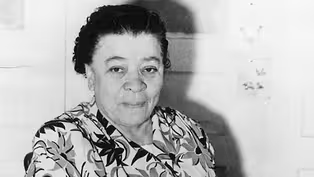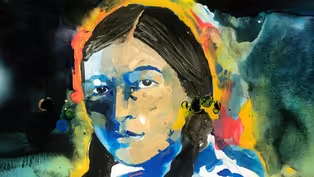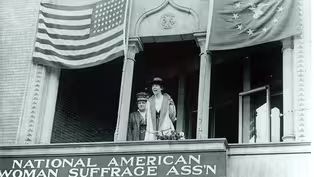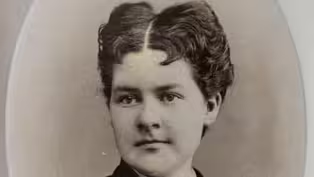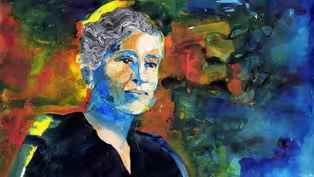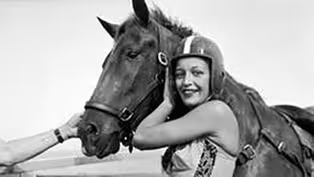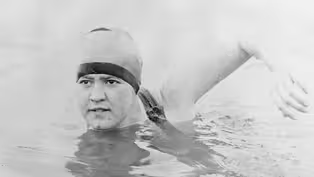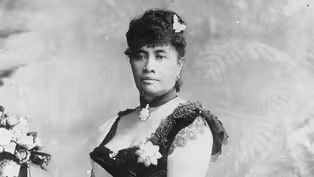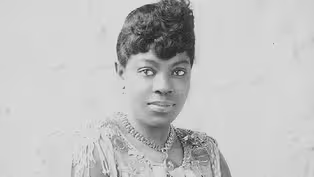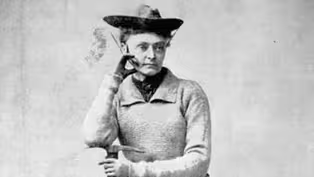
Lillian Gilbreth: Pioneering Inventor
Special | 10m 20sVideo has Closed Captions
Lillian Gilbreth was the first woman elected to the National Academy of Engineering.
Lillian Moller Gilbreth is the first woman elected to the National Academy of Engineering and the first female engineering professor at Purdue University. She worked to invent time and motion studies with her husband Frank, and elevated women’s labor in the domestic sphere with her design of the L-shaped kitchen and numerous appliances.
Problems playing video? | Closed Captioning Feedback
Problems playing video? | Closed Captioning Feedback
Support for American Masters is provided by the Corporation for Public Broadcasting, AARP, Rosalind P. Walter Foundation, Judith and Burton Resnick, Blanche and Hayward Cirker Charitable Lead Annuity Trust, Koo...

Lillian Gilbreth: Pioneering Inventor
Special | 10m 20sVideo has Closed Captions
Lillian Moller Gilbreth is the first woman elected to the National Academy of Engineering and the first female engineering professor at Purdue University. She worked to invent time and motion studies with her husband Frank, and elevated women’s labor in the domestic sphere with her design of the L-shaped kitchen and numerous appliances.
Problems playing video? | Closed Captioning Feedback
How to Watch American Masters
American Masters is available to stream on pbs.org and the free PBS App, available on iPhone, Apple TV, Android TV, Android smartphones, Amazon Fire TV, Amazon Fire Tablet, Roku, Samsung Smart TV, and Vizio.
Buy Now
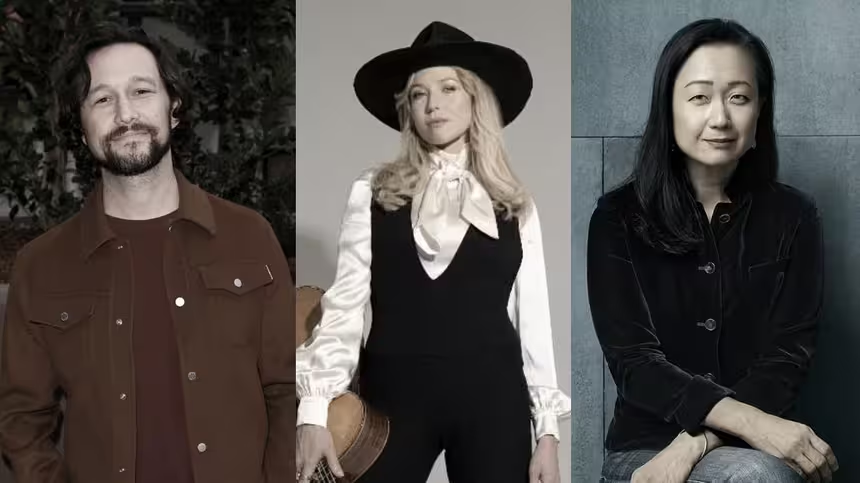
A front row seat to the creative process
How do today’s masters create their art? Each episode an artist reveals how they brought their creative work to life. Hear from artists across disciplines, like actor Joseph Gordon-Levitt, singer-songwriter Jewel, author Min Jin Lee, and more on our podcast "American Masters: Creative Spark."Providing Support for PBS.org
Learn Moreabout PBS online sponsorshipMore from This Collection
The First Black Woman to Run for Vice President of The U.S.
Video has Closed Captions
Charlotta Bass was the first Black woman to run for Vice President of the United States. (12m 32s)
Zitkála-Šá: Trailblazing American Indian Composer and Writer
Video has Closed Captions
Zitkála-Šá co-composed and wrote the libretto for the first American Indian opera. (11m 39s)
Jeannette Rankin: The First Woman Member of U.S. Congress
Video has Closed Captions
Jeannette Rankin made history as the first woman elected to the U.S. Congress. (12m 38s)
Jovita Idar: Mexican American Activist and Journalist
Video has Closed Captions
Jovita Idar was a Latina journalist who worked for an end to segregation and racism. (11m 8s)
Martha Hughes Cannon: The First Woman State Senator
Video has Closed Captions
Martha Hughes Cannon was a historic state senator and public health pioneer. (12m 23s)
She was a Civil Rights Activist and Co-Founder of the NAACP
Video has Closed Captions
Mary Church Terrell was a suffragist, civil rights activist and co-founder of the NAACP. (11m 53s)
She was a Daredevil Performer & Advocate for the Blind
Video has Closed Captions
Sonora Webster Carver (1904-2003) was one of the most famous horse divers in the world. (10m 2s)
She was the First Woman to Swim Across the English Channel
Video has Closed Captions
Gertrude Ederle made history in 1926 as the first woman to swim across the English Channel (11m 54s)
Queen Lili‘uokalani - The First and Last Queen of Hawai‘i
Video has Closed Captions
Queen Lili‘uokalani was the first sovereign queen, and the last monarch of Hawai'i. (12m 14s)
Sissieretta Jones was a Trailblazing Black Opera Singer
Video has Closed Captions
Sissieretta Jones was the first Black woman to headline a concert at Carnegie Hall. (11m 5s)
The First American Indian Doctor
Video has Closed Captions
Susan La Flesche Picotte became the first American Indian woman doctor. (11m 37s)
Annie Smith Peck: Record-Breaking Mountaineer
Video has Closed Captions
She was a record-breaking mountaineer, educator and suffragist. (10m 40s)
Providing Support for PBS.org
Learn Moreabout PBS online sponsorshipShe changed the way Americans work.
She's the first industrial engineer who really brings to bear human psychology in the workplace.
1912, Providence, Rhode Island, 34 year old Lillian Moller Gilbreth and her husband Frank introduced workers at a manufacturing plant to what's known as 'Scientific Management'.
Frank studies the motions and how you can economize on the motions.
Everything's done by the stopwatch.
He times workers, and he says, how can we make this faster, faster, faster.
But Lillian is interested in worker satisfaction.
She's looking at their faces, how do I make them happier with the work they're doing?
She thought about the workplace environment.
Maybe there needs to be more light, maybe there needed to be bigger windows.
Maybe the workers needed to take a break.
And that is the one little element that's going to separate the Gilbreth system from all the other scientific managers out there.
That's their innovation and it's Lillian's.
The workers must understand that they add to the perfectness of the entire establishment.
Scientific management is built on the recognition of the individual, with all the idiosyncrasies that distinguish a person.
Lillian Moller Gilbreth was born in 1878 in Oakland, California, to parents of German descent.
Lillian is one of these rare women who was born in great privilege and her parents' expectation for her was life of domesticity and it was something that she very clearly rejected.
My mother said, "A lady should only appear in the newspaper three times- in the births, the marriages, and the death column."
But I wanted all the education I could get, a job to do.
Overcoming her father's initial objections to a woman attending college, Gilbreth graduated from UC Berkeley in 1900 with a bachelor's in English.
She decided to pursue a master's at Columbia University.
So she goes to New York, and the graduate advisor she came to work with doesn't want to work with her.
He said, "She is not going to distract my classes, or me!
I'm still old fashioned enough to believe that a woman's place is in the home."
But it was actually a blessing in disguise because she goes to work with a man named Edward Thorndike who has some very new ideas about how environment affects people's psychology.
And everything that she starts to do from here on out is really based on this idea.
However, Thorndike was also a prominent figure in the eugenics movement.
Eugenics was interested in applying Charles Darwin's theory of natural selection to humans.
The movement comes to America around 1900 or so, where white elites carved up the world into different kinds of types, ranked on a hierarchy with African Americans and other people of color on the bottom, Southern Europeans, Eastern Europeans, up until white Anglo Saxon Protestants.
Scientists like the Gilbreths would be enlisted in the eugenics movement because they were interested in the issue of improving their own racial stock, so that they would not lose their dominant place in society.
We want intellectual women as mothers for the race.
And the Gilbreths quite literally have a child every year and a half, and Lillian's on board.
So they became the poster family, if you will, because they looked like the kind of family that eugenicists were hoping would be the model for all white elites at the time.
In 1909, the Gilbreths moved to New Jersey to engage with industrial engineer Frederick Winslow Taylor, the 'Father of Scientific Management.'
After the Civil War, we have this huge industrial revolution in the United States.
And he comes up with ways to make what's going on in factories much more efficient.
His methods become very popular with industrialists who are trying to save money.
But it was also a way to exploit the American worker.
By 1910, the Gilbreths opened their own consulting practice with clients ranging from camera to rubber manufacturers.
They invent this idea of 'therbligs', which is Gilbreth spelled backwards, and they believe that every activity that goes on, is some combination of these 17 actions.
Frank understands that most of his clients need to see Lillian as the assistant, but the truth is that she's the one starting to really revolutionize this idea of industrial psychology.
She didn't think just of how the technology worked, but she thought about how it would affect the people that were using it.
I'm Lisa Seacat DeLuca.
I'm a distinguished engineer, a director and an inventor at IBM.
I am now working for our Watson Internet of Things division at IBM.
It's this concept that all of the things around us can connect to each other and to the internet to share information.
And a lot of that is putting yourself in the shoes of the everyday worker.
What do they need?
What kind of technology will help them do their job better?
So we're thinking about innovation exactly the same way that Lillian did.
As later fictionalized in bestselling memoirs written by their children, the Gilbreths used their large family as a testing ground for their ideas.
"18 seconds, not bad, not bad.
You ready?
Go."
I cannot even begin to tell you all the little different charts and methods they had with these children.
So in many ways, they make their own home scientific.
It was fun to turn the whole house into a motion study laboratory.
The children felt they were making a real contribution.
Lillian Gilbreth earned a PhD in psychology from Brown University in 1915, but found it difficult to get her work published.
Although she co-wrote many of Frank's early books, she rarely got the credit.
Sometimes her name's on there, but if it's on there, it's L.M.
Gilbreth.
So no one thinks it's a woman that's writing these papers.
Gilbreth received public recognition in 1921, when she became the first woman honorary member of The Society of Industrial Engineers.
This was a complete surprise and a tremendous thrill.
However, after Frank's death in 1924, most corporate clients canceled their contracts, unwilling to take Lillian Gilbreth seriously.
And so along with grieving her husband, now she has to reinvent herself.
I'm going to focus on things that people think I can legitimately do as a woman, women's work, and quite literally, this woman has her own solo career for the next 50 years.
Gilbreth invented the L-shaped kitchen, the foot-pedal trash can, refrigerator shelvings, and many other home efficiency designs.
She's basically infusing that domestic role of the homemaker with value.
Whether we like it or not, the machine age is upon us and it is a distinct advantage for the woman who wants to save time for other things outside her home.
There's a recent study that showed that of all people that are recognized as inventors, only 12% are women.
Becoming IBM's most prolific female inventor has given me a lot of opportunities that I might not have had otherwise.
Things like becoming a role model for that next generation of engineers, and specifically I have a, you know, a soft spot for women.
I want to get more women excited about STEM.
From 1935 to 1948 Gilbreth was the first female professor at Purdue University's School of Engineering.
What's beautiful about that time in her life is all of those innovations she brought to Frank's work are now considered legitimate.
An actual academic discipline.
In 1965, Gilbreth was the first woman elected to The National Academy of Engineering.
She retired in 1968, at age 90, having put all 11 of her surviving children through college.
Although there's no evidence of Gilbreth publicly disavowing her ties to eugenics, the movement fell out of favor in the U.S. As it was embraced by Hitler in World War II.
She is a white upper-class woman of those times and her attitudes that there are some people who are more fit, is something that we need to name and own, but take that with the fact that she's made important and significant contributions in scientific and engineering fields.
The research so near to my heart would be carried on by other people.
And that was the only thing that mattered.
My life ideal, work, and passion would go on.
Support for PBS provided by:
Support for American Masters is provided by the Corporation for Public Broadcasting, AARP, Rosalind P. Walter Foundation, Judith and Burton Resnick, Blanche and Hayward Cirker Charitable Lead Annuity Trust, Koo...

